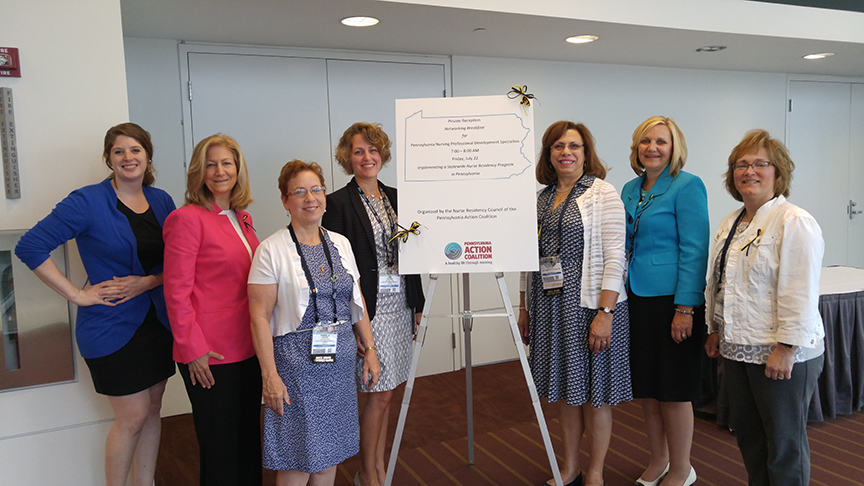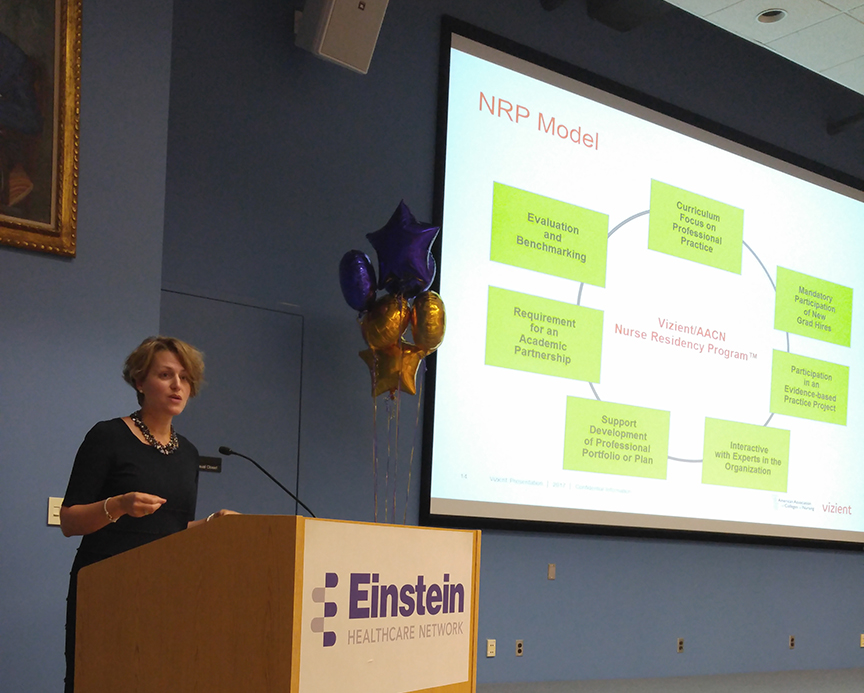
Networking Breakfast for Pennsylvania Nurse Residency Collaborative.
From Left to Right: Sarah Hexem, Mary Lou Kanaskie, Pam Meinert, Amy Ricords, Cathy Witsberger, Cindy Cappel, and Faye Gardner.
“Every new nurse should have access to a high-quality residency program. Yes, you need to stay competitive for recruitment. Yes, there is an impressive return on investment when looking at retention. But, honestly, we are at a point where it is just the right thing to do,” says Amy Ricords, MEd, BSN, RN-BC.
Ms. Ricords currently chairs the Steering Council for the Pennsylvania Nurse Residency Collaborative (PA-NRC). The PA-NRC officially launched in August 2016 as a strategic partnership between the Pennsylvania Action Coalition and Vizient, Inc. Through the PA-NRC, hospitals throughout the Commonwealth can access the Vizient/AACN Nurse Residency Program™ at a discounted rate and receive additional state-level networking and technical assistance opportunities. The Institute of Medicine’s Future of Nursing Report recognized nurse residency programs as instrumental in improving the quality of healthcare. Pennsylvania is the third state to implement the NRP at a state level. To date, 57 hospitals in Pennsylvania participate in the PA-NRC.
“Unfortunately, although all health care settings hire new graduate nurses, residency programs have not permeated beyond larger acute care settings,” states Ricords. When not volunteering with the PA Action Coalition, Ms. Ricords serves as the Director of Nursing Education and Professional Development at Penn State Health Hershey Medical Center, where the Vizient Nurse Residency Program was implemented in 2010. Ms. Ricords has also worked in homecare, acute rehab, acute care, and in various leadership positions. “In every setting, I can see the value that the curricular components of the Nurse Residency Program would bring.”
Ms. Ricords is particularly interested in the generational dynamics of the nursing workforce. As the baby boomers seek successors and nursing schools turn out millennials by the thousands, health care systems are challenged to think creatively about how to quickly and effectively support emerging nurse leaders. “When we look at our entry level nurse leader positions, nearly 50 percent of graduates are from the Nurse Residency Program. We aren’t just transitioning the new nurse, we are fostering the next generation of nursing leadership,” she says.
With hospitals clamoring for Magnet status and high competition for new graduates, most health care systems are looking to residency programs that can be accredited and typically those programs have a price tag. For systems hiring hundreds of new graduates a year, the cost-benefit is clear. “The challenge is that many smaller hospitals that hire fewer graduate nurses, see the large systems and say, ‘that isn’t for us.’ Yet, small cohorts are often even more effective because they can be so closely tailored to the needs of those nurses. And the margin for smaller hospitals means that preventing even one nurse from leaving prematurely makes a huge difference.”
Ms. Ricords is working with the Steering Council, the Pennsylvania Action Coalition, and Vizient, to find new ways to bring the Nurse Residency Program to smaller hospitals, rural health settings, and non-acute settings. “The first year of the PA-NRC was about getting up and running, establishing critical mass, and building a sense of community. Now, we are looking at how to leverage the wealth of experience across the state to support nurses’ practice in health settings of all kinds.”

Amy Ricords conducting the Pennsylvania Nurse Residency Collaborative Implementation Training at Einstein Medical Center.


